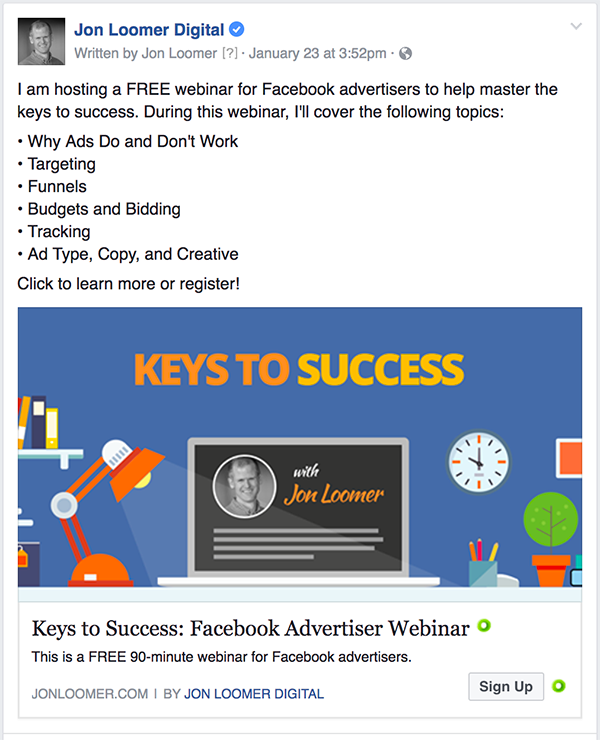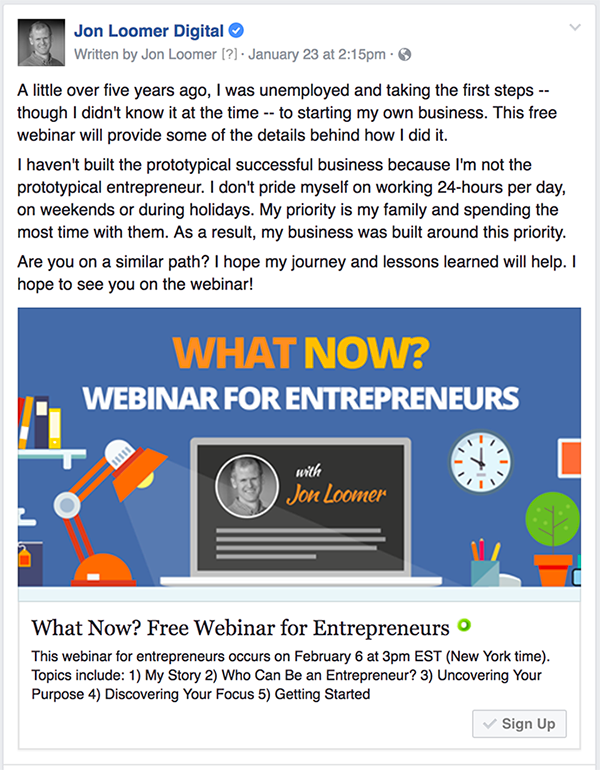There are many factors that lead to success or failure of your Facebook ad campaign. But spoiler alert: Nothing is more important than targeting.
Nothing comes close.
You could craft the perfect ad with convincing copy and eye-grabbing imagery. You could lead to a super-fast landing page with laser precision and focus. The product could be so compelling that it sells itself.
But if your targeting sucks? Forget about it.
My results tend to reflect this. I don’t pride myself on insanely compelling copy and imagery. I’ve never claimed to be a great salesperson. My ads themselves tend to be… fine. But they aren’t why I get results.
There is no better example of this than a couple of campaigns I started running on Monday. I wanted to share them with you along with the results.
The Campaigns
Beginning on Monday, I decided to finally start a couple of Facebook campaigns to promote Keys to Success: A Free Webinar for Facebook Advertisers, which occurs next Monday. While that may sound like last minute, I’ll undoubtedly need to shut off registration soon. Why? It’s going to fill up.
Part of that is because I emailed my list about it. But another reason is the insane number of signups I’m getting via the Facebook campaigns.
I created two campaigns:
- Keys to Success Webinar – Lead Generation (using Lead Ads)
- Keys to Success Webinar – Website Conversions (driving to a landing page)
I like to use both methods to see what works best. Little did I know that I’d get insane results from each one.
The Targeting
I created one ad set for the Lead Generation campaign and two for the Website Conversions campaign. In the second campaign, I created two so that I could test two different audiences. I could have (and maybe should have, once you see the results) created two ad sets for both. But I honestly didn’t expect what ended up happening.
While there were three total ad sets, the targeting was the same between the Lead Generation campaign and one of the ad sets in the Website Conversions campaign. So here are the two targeting approaches that I took…
1. Page Engagement Custom Audience
Targeted Audience: All Page Engagement (365 Days)
Excluded Audiences:
- Keys to Success Webinar Registrants (Data Custom Audience)
- Keys to Success Webinar Registrants (180 Day Website Custom Audience)
- Keys to Success Webinar Registrants (Lead Ad)
- Visited Keys to Success Webinar Landing Page 2+ times (180 days)
2. Most Engaged Website Visitors
Targeted Audiences:
- All Website Visitors 2+ Frequency (180 Days)
- Time on Site Top 25% (180 Days)
Excluded Audiences:
- Keys to Success Webinar Registrants (Data Custom Audience)
- Keys to Success Webinar Registrants (180 Day Website Custom Audience)
- Keys to Success Webinar Registrants (Lead Ad)
- Visited Keys to Success Webinar Landing Page 2+ times (180 days)
If you aren’t familiar with Page Engagement Custom Audiences, this is relatively new. This allows me to target anyone who engaged with my Facebook page in any way during the past 365 days.
Targeting my most engaged website visitors can be done with a couple of relatively new Website Custom Audience features as well (this and this).
I dedicated a $40 daily budget to target my engaged website visitors within the Lead Generation campaign and another $50 for that same audience and $10 for the page engagement audience in the Website Conversions campaign.
The difference in budget is due to audience sizes. My engaged website visitors audience is just under 200,000 people while I have just under 50,000 people engaged with my page.
While the groups I targeted is important, don’t overlook the exclusions. I made sure to exclude people who already registered for the webinar in three different ways (email address, thank you page website visitors, and lead form). I also excluded anyone who visited the landing page twice or more (I assume that’s enough).
This helps mitigate loss once people start converting. I don’t want to throw money away at people who already converted or who repeatedly visited the landing page without converting.
The Ads
When I shared some preliminary results to my Power Hitters Club – Elite community, one question quickly came up: What was your ad? Can you share it?
I was somewhat embarrassed to share it. I don’t consider it all that interesting (it’s really not). But here it is…

The ads for the Website Conversion campaign and Lead Generation campaign were virtually identical. More information was found within the landing page for the Website Conversion ad and within the lead ad form within the Lead Generation ad.
If you’re wondering why neither ad provides details on date and time of the webinar, it’s because I plan to make this a monthly thing. So once I start the webinar on Monday, the date and time switches. This allows me to keep the current campaign running.
Overall, though, it’s pretty disappointing, right? You were expecting to see some magic. Not really all that special. Anyone could have done it.
The Results
But that leads us here…
To build leads through Facebook ads, a good goal is to spend about $1 per email address. But it could easily cost more than that, depending on several factors. And it may or may not be worth those costs, depending on the value of a lead to your business.
So with the $1 goal in mind, here are the results for my Lead Generation campaign…

And for the Website Conversions campaign…

So as I type this, I’ve spent a grand total of $292.39 to accumulate 1,447 registrations (and counting). That’s a nifty cost per registration of 20 cents.
That’s an insanely low cost.
The Importance of Targeting (and BUILDING)
You can have some success targeting interests, behaviors and Lookalike Audiences. You can have better success targeting website visitors and (apparently) people who engage with your page. But the problem, of course, is scaling.
I could stand to increase my budgets a little more (and I will). But I will be capped and can’t spend much more, particularly for the people engaged with my page. Scaling has a very short ceiling in this case.
But that’s why building audiences is so important. If I didn’t put so much effort into content, building my list and promoting my content, I would not have a large audience to target in the first place. I wouldn’t be able to focus in on the most engaged website visitors. And I would be restricted by far smaller budgets.
But thanks to those years of hard work, I see the payoff with campaigns like these. While others are paying $1,500 – $3,000 to get that same number of registrations, I pay a small fraction.
Having a long-term plan pays off.
In Comparison
I shared my insane success, but how about something similar that has been far less successful?
A week after my Keys to Success webinar, I’ll be hosting a webinar for entrepreneurs called What Now?. It’s a new topic for me. A little experiment.
But since it’s a new topic, I don’t have a built-in audience of people I know who are interested in it. I have a website custom audience of about 10,000 people who have read my four blog posts on the topic. That’s about it.
As a result, I had to go with less precise targeting. In one ad set, I targeted those 10,000 people who read my entrepreneur posts. Obviously, a very low budget. In another, I targeted all of my website visitors who also had interests in entrepreneur-related topics.
Of course, I’m not a big believer in interest targeting. This blog post is a good example why. So targeting my audience (not necessarily entrepreneurs) and layering on entrepreneurial interests (not necessarily accurate) was not a sure-fire approach.
The ad wasn’t much different at all from what I did for the Facebook ads webinar…

The results? I’m spending more than $1 per email address in this case. Actually, about $1.50. More than I am accustomed to spending, and far more than I’m spending for a comparable webinar. If I don’t tweak it to get better results, I’ll need to stop it soon.
What’s the difference? It should be obvious by now.
It’s the targeting, stupid.
Your Turn
Are you seeing significantly better results when targeting people who are most engaged with you? Are you willing to share those results?
Let me know in the comments below!






